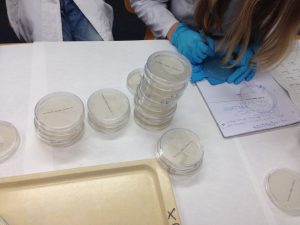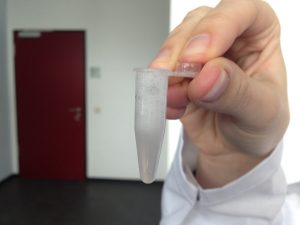In this post, student bloggers Lara and Kati report on their uniqe and exciting first-hand experiences during their Toxicology Lab Course.
At the beginning of march, the first year Master students were given two tasks as part of their Toxicology Lab Course: we measured the mutagenic potential of a test-substance of our choice and determined metabolism and excretion of caffeine within our own bodies (the “caffeine experiment”).
Mutagenic potential was assessed with the common and highly standardized AMES test, a reverse mutation test using two strains of Salmonella bacteria. Due to the induction of a mutation in a distinct gene locus, a single bacteria cell gains the ability to grow on a selective test plate and form a colony that becomes visible. Results were obtained for test substances such as engine oil, an energy drink, and a synthetic sweetener by counting the reverse mutant colonies. A comparison of the negative controls and the positive controls to the number of colonies grown on the treated agar plates after 48 hours luckily did not yield any mutagenic effects in any of the tested substances.
In preparation of the second task, the “caffeine experiment”, we had to go through a tough week: we were asked to refrain from consuming any food and beverages containing caffeine (e.g., coffee, tea, coke, and chocolate) to get rid of caffeine and its metabolites in our bodies until test initiation. The fact that this phase of abstinence coincided with the exam period and deadlines for individual project work also needed to be met, did not particularly help :-).
Our struggle finally ended on Thursday morning, when we were allowed a rush of caffeine: we drank a full 2.9 mg caffeine/kg body weight at once, which amounts to 2.5 – 4 cups of coffee, depending on the individual body weight. Fully awake, in a good mood, and with sharpened attention, we started sampling of saliva in regular time intervals for the following 24 hours. Afterwards, we got our samples analyzed for caffeine content with the help of a liquid chromatography with subsequent mass spectrometry.
Among the first-year Master students, caffeine elimination rates varied largely, with some students reaching a zero-level of caffeine within the 24 hours, while others still had approximately one third of the initially consumed caffeine concentration in their bodies.
All in all, it was a really interesting lab week, by which ecotoxicology-students gained an insight in a toxicologist’s field of work. We gathered some experience in conducting a frequently-used and easily-applicable method of measuring mutagenicity, the AMES test, and were given the chance to also study the metabolism of a drug, namely caffeine, within our own bodies.


